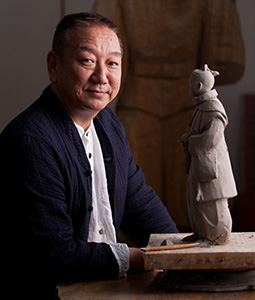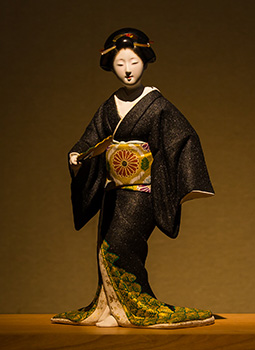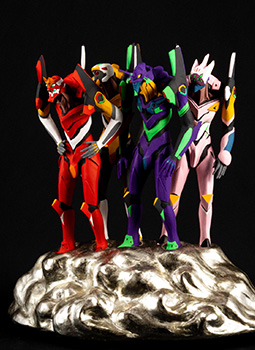March 2022
- English
- 日本語
Hakata Ningyo Expressing Human Emotions

A Hakata Ningyo depicting the folklore hero Momotaro made by Nakamura Shinkyo

The figurine of Ito Mancio presented to Pope Benedict XVI in 2011 
Hakata Ningyo maker Nakamura Shinkyo 
“Matsu no Kotobuki,” a Hakata Ningyo made by Nakamura Shinkyo depicting a performance of a Japanese traditional dance to a song of that name 
Figurines based on the robots that appear in the popular Japanese anime Neon Genesis Evangelion

Hakata Ningyo (Hakata Dolls) are unglazed porcelain figurines* produced in Hakata, Fukuoka Prefecture. The figurines, which have noh and kabuki actors, beautiful women, and children as their traditional subject matter, are distinguished by their “personality” and rich, delicate coloring.

Hakata Ningyo are traditional dolls produced in the Hakata area of Fukuoka City in the northern part of the island of Kyushu in southwestern Japan. The figurines are made of a fine-textured clay that is pressed into a hollow mold then dried and fired at a low temperature without a glaze. The dolls are covered with a white pigment undercoat and then painted entirely by hand. There are various theories as to the origin of these figurines, but it is said that a roof tile craftsman began firing dolls about 400 years ago.
Later, from about 200 years ago, the current Hakata Ningyo techniques were established. Plaster molds are reproduced from the original clay molds. Then unglazed porcelain figurines of the same shape as the originals are made using these molds. Many Hakata Ningyo were created during the period of high economic growth in Japan in the 1960s featuring women performing classical Japanese dance, noh and kabuki actors, and other actors from traditional performing arts. These figurines came to be known for well representing the beauty of Japan, giving birth to a Japanese saying, “as beautiful as Hakata Ningyo.”

Nakamura Shinkyo is the third-generation craftsman at Nakamura Ningyo, which has been producing Hakata Ningyo for around 100 years. Shinkyo says, “Hakata Ningyo were already recognized around the world for their value at the turn of the twentieth century. The excellent creative techniques used to make the Hakata Ningyo displayed at the 1900 Exposition Universelle de Paris were highly praised, and this led to requests for various statues from all across Europe. It seems that there was a particularly large number of requests for statues of saints for churches.”
If you visit churches around Europe today, you can still see Hakata Ningyo statues of Joseph and Moses made by Shinkyo’s father and grandfather.
The prosperous city of Hakata flourished as an international trading port that had been open to East Asia since ancient times. Shinkyo says that the nature of the city enabled Hakata Ningyo craftsmen to develop their skills by incorporating new and diverse techniques and methods, and that they could create anything requested. “At Nakamura Ningyo, there are no rules at all that must be followed, not even for methods, techniques or subjects.”
The Hakata Ningyo that Shinkyo works on are unconstrained and varied, depicting not just traditional subject matter but everything from gorillas in a zoo to large heart-shaped mailboxes. In 2011, Shinkyo presented a figurine to Pope Benedict XVI depicting Ito Mancio, one of the Tensho envoys**, the first Japanese people to have an audience with the Pope in Rome in the late sixteenth century. Among Shinkyo’s works, the figurines of robots that appear in the popular Japanese anime and social phenomenon from the 1990s Neon Genesis Evangelion have attracted particular attention recently. These figurines were made on request in 2021 to coincide with the theatrical release of the newest movie in the Evangelion franchise.

“I value a realism in Hakata Ningyo that expresses ordinary reality, and it was quite difficult to figure out how to express realism in robots, which are originally based in fantasy,” says Shinkyo.
He adds that regardless of the motif, he creates figurines by incorporating a “prayer” to express the reality of the times and life in a way that is meaningful to people. He says that for this reason, he doesn’t want Hakata Ningyo to be called “dolls” in English but rather by the Japanese term, “ningyo.” (“Ningyo” means “human” (nin) “shape” (gyo).)

Hakata Ningyo are not created merely as traditional ornaments, but rather to express the personality of beautiful women and children from different periods of time. It can be said that the figurines do not simply display exterior form, but are works of art that attempt to express everyday human realism and the full range of internal emotions. They possess a reality that speaks to the viewer.
* Porcelain fired without applying a glaze to the clay
** A mission of four young men dispatched with the goal of having an audience with the Pope in Rome in the 16th to 17th centuries. They departed in 1582 and returned to Japan in 1590.

